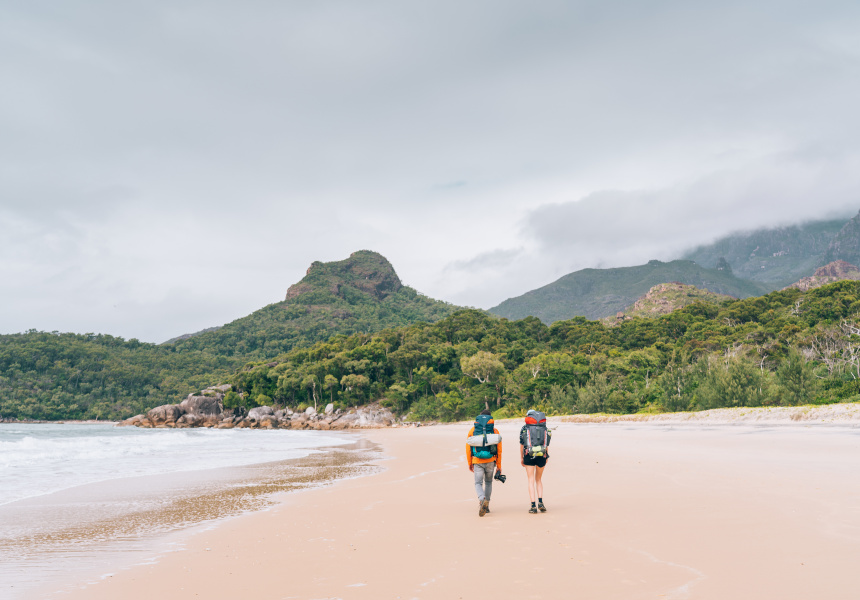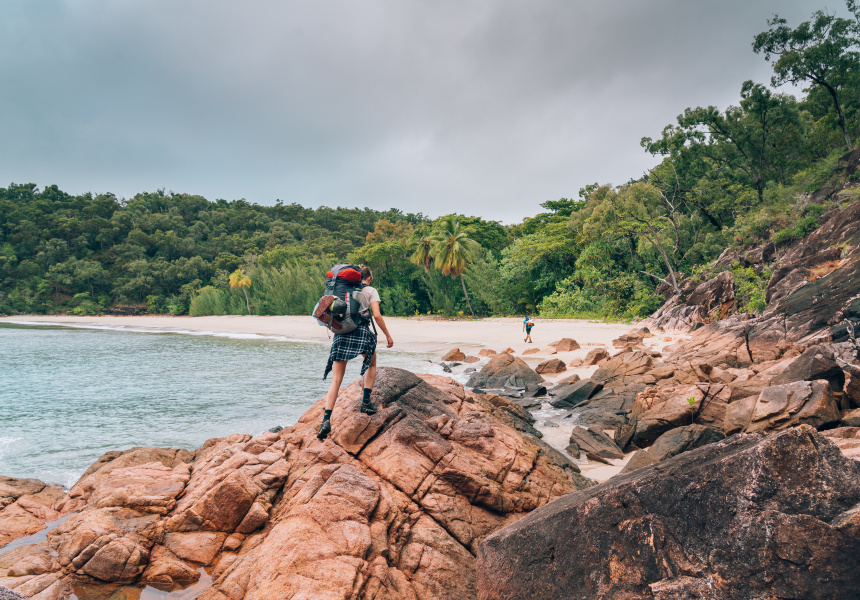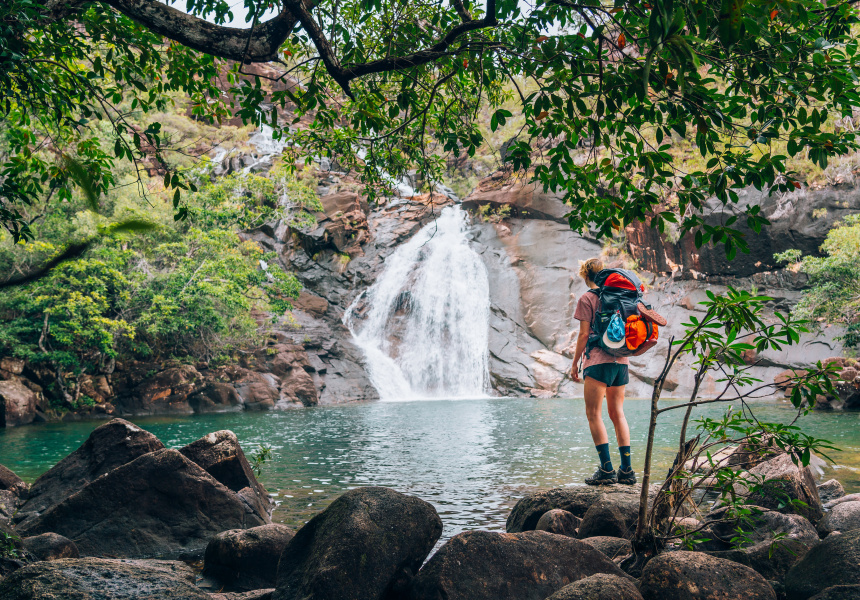It’s a literary cliche to describe open water as “glassy”. It’s just so apt, though. I don’t mean anything so bland as mirrors or windows, but the kind of amorphous, molten, blue-green glass you see sagging off a glassblower’s rod as it emerges from the furnace.
It’s this texture that stretches out endlessly around our little rigid-hulled inflatable, as we surge throatily towards a craggy island, known to the local Biyaygiri people as Pouandai. The tallest peak stretches a kilometre into the sky, grazing the bottom of the clouds. The wind is massaging, rather than whipping, the wine-bottle surface of the water into corrugations and wrinkles that shift as slowly and hypnotically as the insides of a lava lamp.
Our captain, Brad White, stares implacably into the distance. Barefoot, dressed in Steve Irwin khakis, wraparound black shades and a battered baseball cap, he’s the quintessential Aussie bloke: laconic, with a suntan like well-worn leather. White’s seen every sort of condition out here and radiates a sense of calm self-sufficiency. For more than 20 years, he’s been operating Hinchinbrook Island Cruises, a water taxi service as much as a tour company. And before that he was a ranger on the island itself – a 40,000-hectare national park located about halfway between Townsville and Cairns on Queensland’s Cassowary Coast.
Never miss a Brisbane moment. Make sure you're subscribed to our newsletter today.
SUBSCRIBE NOWWhite steers the boat into an overgrown delta of labyrinthine mangrove channels, happily indulging us whenever we ask for a story about a local shark or croc attack. All four passengers are city slickers and this stuff is just as thrilling to us as it might be to someone from Germany or Scotland.
A way up a channel that looks identical to those either side of it, we stop at a floating pontoon, slap on sunscreen and pile out of the boat. After 20 minutes of the boat’s twin engines droning on, the stillness and silence are eerie. I imagine crocs watching us from under the lapping glass-water, but none appear.
We troop along an elevated boardwalk that White helped build. It’s a few hundred metres long. I’m in awe that a small crew of workers was able to cut through such dense, stubborn mangroves and drive piles into the water beneath. And in the Far North Queensland climate – it’s the second day of winter and 30 degrees. I voice my thoughts and White shrugs off the feat in that laconic way of his. He makes it sound like building a backyard shed.
We reach a broad sandy track and follow it for a few minutes, emerging onto a long, windswept beach bookended by majestic peaks. White bends down and shows us some of the delicate fossils that wash up here regularly – pebbly tombs for prehistoric crustaceans. Straight ahead, it’s open ocean, with Vanuatu some 2000 kilometres beyond the horizon.
We’re close to the start of the Thorsborne Trail, the reason most people come to Hinchinbrook Island. White drops small groups here and picks them up four days and 32 kilometres later, on the other side of the island. Just 40 people are permitted on the trail at any one time, so hikers virtually have the place to themselves, carrying everything they need and overnighting at rudimentary campsites. It’s apparently spectacular, full of waterfalls, sweeping views, rock-hopping, eucalyptus forests and a famous natural infinity pool.
We sadly don’t have that kind of time. We troop back to the boat, zoom back up the mangrove channels and back out into open water. White skirts the boat around the island’s northern tip and shows us the remains of the island’s sole resort, damaged by Cyclone Yasi in 2011 and subsequently looted. Later, it burned down in suspicious circumstances – possibly the work of local eco activists.
The concrete remains stretch up a steep hillside, choked by the vigorous tropical flora typical of this area. White shakes his head and explains it was always a low-impact sort of place anyway, one that brought money to the area and fostered interest and conservation efforts on the island. He’s a fantastic guide, full of all sorts of local gossip and history.
He turns the boat around and we make for a little speck named Garden Island, adjacent to the sleeping giant that is Hinchinbrook. There’s no pontoon here, and White’s wary as he brings us into the beach and unfolds a little set of steps from the bow. We jump out and hustle to an elevated drop-toilet, eyes peeled for crocs. Nada.
Without a word to the rest of the group I charge up an overgrown rainforest track, keen to see where it leads. Ten easy minutes later I’m at the island’s central “summit”, if you could call it that. There’s a little park bench from which to admire the views across the channel to big daddy. I do, before returning to the group. They’re already on the boat, full of macabre jokes about my “disappearance”. We won’t see any crocs, but they’re constantly on the mind.
Soon we’re on the way back to One Mile Creek marina at Cardwell, sipping cans of XXXX Gold and lemonade that White fished out of a little esky for us. I’m sitting up at the bow, looking dead ahead, still mesmerised by the water. Suddenly he cuts the engines inexplicably, causing everyone to start.
“Dugongs!” he says, pointing into the distance, right where I was looking. I think he’s pulling our leg, but his eyes are just keener, more experienced. After a couple of minutes of being told how and where to look, we see them. It’s a little herd, maybe a dozen or so. Their boofy seal-like heads are popping above the surface here and there as they duck and dive to forage on seagrass.
We marvel for 10 minutes or so before White fires up the engines and brings us back to the innumerable jetties of One Mile Creek, telling us about the marina’s rocky history. At one time it was touted as a big holiday destination and attracted swarms of developers. That was before Cyclone Yasi, flooded it with mud. A decade on, after persistent lobbying, the federal government finally stumped up the $1.5 million needed for dredging, but work is yet to be started. At low tide all the boats are beached. Most of the surrounding McMansions are currently empty.
I feel for White, whose once-thriving business has been whittled down to almost nothing since this huge natural disaster. Just him and one other operator, Absolute North Charters in Lucinda, share the load of ferrying 10 people a day to Hinchinbrook to hike the Thorsborne Trail.
Another more selfish part of me is glad for this ghost town of a marina we’ve pulled into. The only other boat we saw today was a two-person commercial crabbing operation – acquaintances of White, who checked in when they saw us stopped in the channel, just to make sure we weren’t in trouble. We didn’t hear any growling jet skis, no fishing boats. It was just us and that glassy, glassy ocean.
The writer travelled to Hinchinbrook Island as a guest of Tourism Tropical North Queensland.
tropicalnorthqueensland.org.au
hinchinbrookislandcruises.com.au
absolutenorthcharters.com.au
parks.des.qld.gov.au/parks/hinchinbrook
parks.des.qld.gov.au/parks/hinchinbrook-thorsborne/camping/thorsborne-trail



